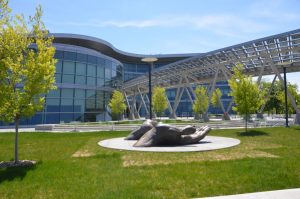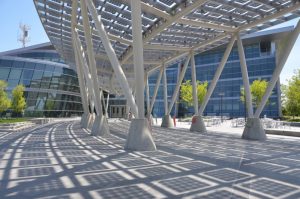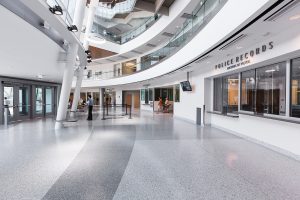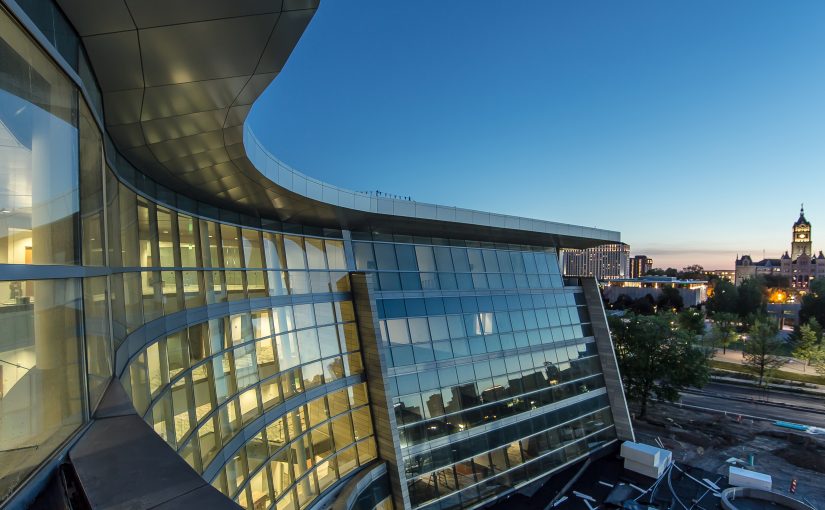A research study surveyed more than 400 city residents on their impressions of various criminal justice agencies and the service they provided. Tucked into the list of questions were a few about the residents’ impressions of the municipal courthouse. The full report on these findings is forthcoming; suffice it to say, however, that the public is more observant of the design and overall upkeep of government buildings than officials might realize. Unfortunately, positive reactions to the building paled in number to those who expressed a sense of nervousness, fear, and intimidation upon entering the city courthouse.
Of course, this was not the first study to investigate how buildings impact the psychology of those inside of them. In 2000, social psychologist Anne Maass and her colleagues at Italy’s University of Padova also discovered that courthouses intimidate people.1 More pointedly, criminologist Andrew Millie found the same regarding police buildings in the United Kingdom.2 In fact, whole academic fields are devoted to the subject of how buildings influence people’s states of mind— environmental and architectural psychology, for example. In the field of criminal justice, in the 18th century, the jurist and philosopher Jeremy Bentham wrote a major work on the optimal design of prison that is still standard reading for correctional scholars today.3 Philosopher Michel Foucault also wrote substantially on the topic.4 In a previous course of ours, a student wrote a paper examining the effectiveness of the Japanese kobans, notable in policing simply because of their unique use of built space—and, really, because of how little space these stations use. One study found that officers in South Korea believed that the smaller, decentralized mini-police stations had actually improved their relationships with the public.5
Despite these important excursions into exploring police architecture, strikingly little research has been done into a re-examination of law enforcement facilities. As human and cultural geography experts Peter Kraftl and Peter Adey explain, buildings serve to “stabilize affect, to generate the possibility of precircumscribed situations, and to engender certain forms of practice, through the design and the planning…”6 Given the times, when communities are calling for more openness, more transparency, and more inclusiveness from their police departments, can the profession afford to neglect the role of law enforcement buildings in how police are perceived? After all, when victims venture to report a crime to the police, they often do so within a police station. When offenders are taken for their initial bookings, they are taken to a police station. When police officers report to work, they typically do so in a police station. When reporters go to get quotes from department officials, when new recruits go to turn in their applications… a lot of law enforcement’s contact with the public and community stakeholders happens at a police station or similar public safety facility. Is it not valuable, then, to consider how to make that contact one where the individual walks away with a positive impression of law enforcement and not a negative one?
Criminal justice research has only just begun working on this goal. Fortunately, there is are potential examples. For example, Salt Lake City’s Public Safety Building (see Figure 1) is a marvel of model architecture, according to several who have written of it.7 The building has its own Facebook page, where public comments such as “great building” and “where the fun happens” can be found.8 Does this sound like how the residents in most towns would describe a police station?

What elicits this response is a form of architecture dubbed OTI—open, transparent, and inclusive—design. This architectural framework developed out of a collaboration with MOCA-PM, a leading owners’ representative firm that assists building owners with the planning, coordination, and technical assistance to bring their projects to fruition with increased efficiency and cost effectiveness.9 Research has shown that positive attitudes toward the police influence how likely one is to cooperate with them. Positive impressions of law enforcement in general carry over to how individuals interpret specific encounters with officers.10 In short, when people thought more positively about the police, they were more likely to cooperate with them. Cooperation is on a continuum, and law enforcement agencies should be doing all that they can to move from a place where citizens are merely willing to comply with police, to a place where citizens are satisfied with them; supportive of them; willing to cooperate with them; and, hopefully, willing to initiate engagement with them.11 There are myriad strategies for doing so, such as, for instance, the use of Tom Tyler’s principles of procedural justice.12 However, building positive public-police relationships should be a comprehensive strategy that includes considering everything, including the police station or public safety building.13 Remember, in many situations, the first sight a citizen has is not of an officer, but of the station building.
Work in this area is ongoing and, as such, is subject to change and constantly being refined. Still, some basic truths about how police buildings can help encourage positive impressions of law enforcement have been established. First and foremost, public safety buildings should incorporate designs that are open, transparent, and inclusive. The principles of OTI should be utilized in every phase of building construction and upkeep, in (1) the selection of the building’s location, (2) the building’s structure, (3) the aesthetic design of the building, and (4) its maintenance.
Location, Location, Location
Planning teams should take several factors into account when deciding on the location of a public safety building. First, it is essential that police stations are close to the communities they serve. Closeness helps and shows the community that the police are readily available to protect and serve. Perhaps a city might do this by locating the headquarters in the jurisdiction’s central district or maybe the agency can staff multiple facilities within several neighborhoods that make up their jurisdiction. The latter approach can ensure at least one police facility is accessible to all community members in any city area.
Reachability means that agencies should ensure that their stations are in areas that be reached by most in the community. The building needs to be easy to find. If someone has to invest a lot of time or effort searching for the police station, it communicates that law enforcement does not care about people being able to contact them. Moreover, individuals may use several modes of transportation as their primary means of travel. Therefore, police stations should be located along bus, trains, or subway lines and reachable by bike, foot, or automobile. Finally, law enforcement must nurture the sense of safety around the station. If fear of victimization keeps citizens from visiting the areas where police stations are, then it shows that police are ineffective when dealing with crime and creates the perception that, when one is in trouble, police stations are not a practical resource.
Architecture Matters
Five design features need to be included in the architecture of public safety buildings. The first of these is functionality. A building needs to be functional for its occupants. For example, a station must have areas for the public to enter and report crime, an area to house police equipment, an area for the gathering of police personnel, secure areas to store information and criminal evidence, and areas to suit any other specific needs of the agency. While it might not seem that these features further the goal of openness, transparency, and inclusiveness, they do so in at least two ways. First, a building that is functional will help improve law enforcement’s effectiveness in providing services to their community. This effectiveness should translate to a more positive public perception of police performance.14 Secondly, a structure that makes police work easier is likely to boost the morale of personnel, and increased officer satisfaction can be tied to better officer performance.15
Public safety buildings must also be accessible. Accessibility is related to reachability, but has some differences. It is possible for a building to be in a reachable place, but remain inaccessible because of its architectural design. For example, when the public entrance is easier to find, members of the public have more positive views of a building.16 Conversely, it would seem a high number of steps or a time-consuming security process to enter the building reduce accessibility and lead to more negative impressions. Once inside a building, navigability can affect public perception. If the public enters a law enforcement facility and finds it difficult or impossible to locate where to report a crime, file a complaint, pay a fine, or make use of other police services, this communicates that their needs are not primary concerns for police officials.
 Despite needing to be accessible and navigable, law enforcement facilities must also be secure. Security is very important on its own, but also influences the public perception in how welcoming the facility is. A police station is a place where dangerous individuals can be brought or housed, dangerous equipment is stored, where protests might be staged, or hostile feelings arise, yet community members must feel safe when they enter a police station in order to feel welcome.
Despite needing to be accessible and navigable, law enforcement facilities must also be secure. Security is very important on its own, but also influences the public perception in how welcoming the facility is. A police station is a place where dangerous individuals can be brought or housed, dangerous equipment is stored, where protests might be staged, or hostile feelings arise, yet community members must feel safe when they enter a police station in order to feel welcome.
Social facility is for the existence of building areas designated public use aside from a reception lobby—the type of areas that prompts a Facebook user to dub the Salt Lake City Public Safety Building the place “where the fun happens.”17 Having spaces available for recreational use sets the stage for public-police contacts outside of crime or emergency situations. Social facility features also allow for staff events. A comfortable and welcoming space that encourages staff socialization can improve staff morale, which can lead to improved service, and, in turn, generate positive feelings towards police. Importantly, a building’s design can encourage more interaction between staff members and the visiting public. Simply placing waiting area seats closer to the department’s front desk might be a small, but effective tactic in promoting positive interaction between the public and law enforcement employees.
Social facility consists of more than promoting social events; it also involves the subtle cues structures give. Placing a police desk so high up that officers have to look down upon visitors can lead people to feel inferior to the police. Law enforcement facility architects should design their structures to avoid subliminal messages that create guardedness among visiting members of the public.
Eye of the Beholder
Consider the visible décor of the station. The structural architecture, while important to the aesthetic design, is not what is being referred to here. Instead, decoration and ornamentation set the tone for how an individual reacts to a building. Research has shown that the use of various colors can trigger feelings of calm, sadness, or anger.
Attractiveness, while vague, generally refers to aesthetic features that are seen as favorable by most viewers. Research shows that there are some characteristics that are “objectively” beautiful—either culturally or inherently ingrained—and incorporating those attractive architectural features into public safety facilities creates a space where people want to be. What qualifies as attractive will vary from community to community.
Appropriateness accounts for the community’s unique character and the part a police facility is expected to play. MOCA’s project in Salt Lake City had to account for the municipality’s desire for the building’s iconicity—the city was looking for architectural design that was striking, bold, and stood apart from its surroundings. Other places—for instance, historic districts—may want new buildings to conform to the shared design of neighboring ones, retaining the thematic feel of the community. In any case, what is appropriate is what fits with the expectations of the community for the buildings in its jurisdiction.
Neutrality concerns the power dynamics within a building’s design, particularly a building associated with the power of the state. A police station is usually equated with prosecution. Thus, any aspect of the building conveying dominance will cause suspects to immediately be on guard and make even innocent citizens nervous. It seems more credible to ensure the space’s perceived neutrality, to disconnect policing from coercion, and change the public’s perception of the place to one focused on the impartial pursuit of justice. Individuals should enter police facilities with the impression that they will be treated with fairness, whether that is in protection or prosecution.
As a final matter of aesthetics, it is critical that the design of the building seems intentional. The incorporation of intentionality in building design is more an art than a science and requires the appearance of genuineness and the avoidance of artificiality. At the same time, people should come away from a public safety facility with a sense that designers put effort into ensuring that the place was welcoming to them and made for them to occupy.
 Maintaining the Vision
Maintaining the Vision
After the building is planned and constructed, the final phase of OTI design is the continuous task of building maintenance. Psychologists Thomas Herzog and Ronda Shier found that, when properly maintained, respondents in their study preferred older buildings to more modern ones.18 Here, three principles are essential. A building’s comfortability refers to an environment’s living condition. From the temperature to lighting to cleanliness, public safety facilities must be kept in a condition that makes them comfortable to be in. As their comfortability diminishes, so will their use by the public, and this will remove an important opportunity to improve the public’s perception of the police.
A building with malfunctioning elevators, fixtures in disrepair, or other mechanical defects demonstrates that an agency that does not care to present itself in its best light. Like the “broken windows” theory that has undergirded so much of community policing strategies, broken buildings invite disrespect; disregard; and, eventually, disorder. Thus, law enforcement facilities must be operable.
Finally, occupancy must stay within a space’s capacity. While building codes often restrict the number of persons that may occupy a building, research has demonstrated a litany of negative effects—stress, high blood pressure, sickness, aggression—when people are placed too closely together or if they feel too confined. The use of spacing, doors, or some level of privacy has been proven to reduce these negative outcomes. Additionally, the overall security or safety within the facilities can become compromised if capacity is disregarded.
All in All
Open, transparent, and inclusive (OTI) design should be a part of a comprehensive strategy to enhance police legitimacy and improve the state of public trust and confidence in law enforcement. It remains to be seen just how impactful this one component of trust-seeking can be when considered on its own. Yet, if law enforcement is intent on strengthening its connection with the general public, it should not leave anything to chance. If building design can assist in efforts to improve public-police relations, let it. OTI design provides a way to do just that. ♦
Incorporate OTI facility design as part of an overall strategy of improving public perceptions of police and police legitimacy.
|
|
Kwan-Lamar Blount-Hill is a third-year criminal justice doctoral student at John Jay College of Criminal Justice/City University of New York Graduate Center. He earned a JD from Emory University School of Law and is a member of the South Carolina, New Jersey, and Georgia Bars. He is a former police officer for the City of Charleston, South Carolina, and a former firefighter for the City of Cayce, South Carolina. Blount-Hill is a research associate at John Jay’s Research & Evaluation Center and John Jay’s Regenhard Center for Emergency Response Studies and has previously worked for the Center for Court Innovation and John Jay’s Center on Race, Crime and Justice. Currently, he teaches criminal justice at John Jay, Rutgers University, William Paterson University, and the Borough of Manhattan Community College. His research focuses include police legitimacy, morality and the law, constitutional issues in criminal law, natural resource crime, and emergency response strategies. Victor J. St. John is a second-year criminal justice doctoral student at John Jay College of Criminal Justice/City University of New York Graduate Center. He earned an MA in criminal justice from John Jay. He is a former cognitive skills facilitator for the Osborne Association, working in various facilities on Riker’s Island. St. John also served as an intervention and assessment supervisor under New York City’s Close-to-Home Initiative. He is a graduate research fellow at John Jay’s Research & Evaluation Center and has previously worked for John Jay’s Center on Race, Crime and Justice. Currently, he teaches criminal justice at John Jay and for the New Jersey Scholarship and Transformative Education in Prisons Consortium (NJ-STEP) at the Edna Mahan Correctional Facility for Women in Clinton, New Jersey, and at Northern State Prison in Newark, New Jersey. His research focuses include corrections, prison architecture, and juvenile justice. Erik Ryan is a senior at Rutgers University School of Criminal Justice. His research interests include corrections and juvenile justice. |
Notes:
1 Anne Maass et al., “Intimidating Buildings: Can Courthouse Architecture Affect Perceived Likelihood of Conviction?” Environment and Behavior 32, no. 5 (2000): 674–683.
2 Andrew Millie, “Police Station, Architecture and Public Reassurance,” British Journal of Criminology 52 (2012): 1092–1112.
3 Jeremy Bentham, “Panopticon” in The Panopticon Writings, ed. Miran Bozovic (London, UK: Verso,1995), 29–95. (Original work published in 1791.)
4 Michel Foucault, Discipline & Punish: The Birth of the Prison, trans. Alan (New York: Vintage Books, 1995). (Original work published in 1977.)
5 Byongook Moon, John McCluskey, and Sangwon Lee, “Korean Police Officers’ Attitude Toward the Efficacy of Mini-Police Stations,” Journal of Criminal Justice 33, no. 5 (2005): 441–449.
6 Peter Kraftl and Peter Adey, “Architecture/Affect/Inhabitation: Geographies of Being-in Buildings,” Annals of the Association of American Geographers 98, no. 1 (2008): 213–231.
7 John Daley, “Salt Lake City’s new Public Safety Building One of a Kind,” Deseret News, December 11, 2012); Janelle Stecklein, “New Public Safety Building Is Not Your Typical Cop Shop,” The Salt Lake Tribune, July 8, 2013.
8 Lisa Hansen, “Salt Lake City Public Safety Building,” Facebook page, review, May 7, 2015; Salt Lake City Public Safety Building, Facebook page, review, May 29, 2015.
9 MOCA-PM (http://moca-pm.com/) provided the funding that made the authors’ research possible. In early 2016, they began an effort to improve their future design practices through reliance on rigorous academic research. That mission brought them to John Jay College of Criminal Justice, where Kwan-Lamar Blount-Hill is a doctoral student, professor, and researcher. Combining Blount-Hill’s study of public-police relations and research experience with their architectural and construction expertise and corporate resources, they have been studying the impacts of buildings on individual and social psychology.
10 Anthony A. Braga et al., The Salience of Social Contextual Factors in Appraisals of Police Interactions with Citizens: A Randomized Factorial Experiment,” Journal of Quantitative Criminology 30 (2014): 599–627.
11 Kwan-Lamar Blount-Hill and Yunho Yeom “A Legitimate Question: A Comparative Look at Police Legitimacy in Asia and in the United States” (presentation at the Annual Conference of the Asian Association of Police Studies, Huntsville, Texas, July 2016).
12 Tom R. Tyler, “Enhancing Police Legitimacy,” The ANNALS of the American Academy of Political and Social Science 593 (2004): 84–99.
13 Kwan-Lamar Blount-Hill and Chad Jones, “Navigating Community Politics and the Public Building Process”(presentation at the Annual Conference and Exposition of the International Association of Chiefs of Police, San Diego, California, October 17, 2016).
14 Justice Tankebe, Michael D. Reisig, and Xia Wang, “A Multidimensional Model of Police Legitimacy: A Cross-Cultural Assessment,” Law and Human Behavior 40, no. 1 (2016), 11–22.
15 Ben Bradford and Paul Quinton, “Self-legitimacy, Police Culture and Support for Democratic Policing in an English Constabulary,” British Journal of Criminology 54, 1023–1046.
16 Pinar Dіnç Kalyaci and Mehmet Bünyamin Bіlіr, “Police Station Facades: Searching the Architectural Characteristics That Can Be Appreciated by All,” Gazi University Journal of Science 29, no. 1 (2016), 35–48.
17 Salt Lake City Public Safety Building, Facebook page, review, May 29, 2015.
18 Thomas R. Herzog and Ronda L. Shier, “Complexity, Age, and Building Preference,” Environment and Behavior 32, no. 4 (2000), 557–575.



